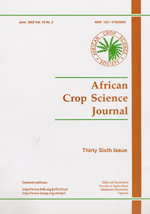
|
African Crop Science Journal
African Crop Science Society
ISSN: 1021-9730
EISSN: 1021-9730
Vol. 27, No. 2, 2019, pp. 281-294
|
 Bioline Code: cs19020
Bioline Code: cs19020
Full paper language: English
Document type: Research Article
Document available free of charge
|
|
|
African Crop Science Journal, Vol. 27, No. 2, 2019, pp. 281-294
| en |
Genotype by environment interaction and grain yield stability of Ethiopian black seeded finger millet genotypes
Kebede, D.; Dagnachew, L.; Megersa, D.; Chemeda, B.; Girma, M.; Geleta, G. & Gudeta, B.
Abstract
Finger millet ( Eleusine coracana

(L.) Gaertn) is an important cereal widely produced in Ethiopia across diverse agro-ecologies. It is valued by local farmers for its ability to grow in adverse agro-climatic conditions, where other cereals fail. The yield potential of this crop is in the range of 4-5 tonnes/ha, but the current national average grain yield is far below the potential (2.1 tonnes). Lack of improve varieties which are stable, high yielder and stress tolerant is a major limiting factor to production of this crop in Ethiopia. A field experiment was conducted using twelve black seeded finger millet ( Eleusine coracana subsp. coracana) genotypes, including local and standard checks (Degu) at two locations (Bako and Gute) in Ethiopia for three years (2014 - 2016). The objective of this study was to identify stable and high yielding genotypes for grain yield and other agronomic traits among the black seeded finger millet genotypes of Ethiopia. The additive main effect and multiplicative interaction (AMMI) model analysis of variance revealed highly significant (P<0.01) differences between environments, genotype, and Interaction Principal Component Analysis (IPCA-I), but significant variations (P<0.05) for G x E interactions. This indicates that the genotypes performed differently over environments and that the test environments are highly variable. Only the first IPCA-I showed high significance (P<0.01) and contributed 48.39% of the total genotype by environment interaction (G x E). Genotypes BKFM0020, BKFM0006 and BKFM0010, which had high grain yield, but with IPCA value close to zero, indicated the wide adaptability/stability. Similarly, analysis using Eberhart and Russell model revealed that these genotypes were within the relatively acceptable range of regression coefficients (bi), approaching to one (0.742, 0.8176 and 1.0578), and deviation from regression closer to zero (s 2di) (0.0385, -0.0661 and -0.0248), respectively. This implied that pipeline genotypes were stable, widely adaptable and high yielders than the other genotypes. Genotype and genotype by environment (GGE bi-plot) analysis also revealed that these candidate genotypes were stable and high yielder. Besides, these genotypes showed resistance to blast disease, which is a threat to finger millet production in the study areas. Therefore, these genotypes were selected as potential candidates for possible release in western Oromia and similar agro-ecologies of the country.
AMMI; blast; Eleusine coracana
|
| |
| fr |
Kebede, D.; Dagnachew, L.; Megersa, D.; Chemeda, B.; Girma, M.; Geleta, G. & Gudeta, B.
Résumé
Le petit mil ( Eleusine coracana

(L.) Gaertn) est une céréale importante largement produite en Éthiopie dans les différents zones agro-écologiques. Il est apprécié par les agriculteurs locaux pour sa capacité de grandir dans des conditions agro-climatiques défavorables, où les autres céréales échouent. Le potentiel du rendement en grain de cette culture de mil se situe entre 4 à 5 t ha-1, mais le rendement moyen national actuel est très inférieur au potentiel (2,1 tonnes). Le manque de variétés améliorées, stables, à rendement en grain élevé et tolérantes au stress est un t facteur majeur limitant la production de cette culture de mil en Éthiopie. Une expérience au champs a été conduite avec douze génotypes des grains noir de mil ( Eleusine coracana subsp. Coracana), y compris des contrôles locaux et standard (Degu) à deux locations (Bako et Gute) en Éthiopie pendant trois ans (2014 - 2016). L’objectif de cette étude était d’identifier des génotypes stables et de rendement très élevé pour le rendement en grain de mil et d’autres caractéristiques agronomiques parmi les genotypes des grains noir de mil en Éthiopie. L’analyse de variance du methode avec effet principal additif et interaction multiplicative (AIM) a révélé des différences très significatives (P <0,01) entre les locations, le génotype et l’analyse en composantes principales de l’interaction (IPCA-I), mais des variations significatives (P <0,05) pour G x E interactions. Cela indique que les génotypes se sont comportés différemment selon les locations et que les locations de test sont très variables. Seule la première IPCA-I a montré une signification élevée (P <0,01) et a contribué pour 48,39% du total des interactions génotype par la location (G x E). Génotypes BKFM0020, BKFM0006 et BKFM0010, qui avait un rendement en grain élevé, mais avec une valeur IPCA proche de zéro, a indiqué la grande adaptabilité / stabilité. De même, une analyse utilisant les méthodes d’Eberhart et Russell a révélé que ces génotypes se situaient dans la plage relativement acceptable des coefficients de régression (bi), se rapprochant de un (0,742, 0,8176 et 1,0578) et de l’écart par rapport à la régression proche de zéro (s2di) (0,0385, 0,0661 et -0,0248), respectivement. Cela impliquait que les génotypes de pipeline étaient stables, largement adaptables et ont eu le rendement très élevé que les autres génotypes. Les analyses de génotype et génotype par la location (bi-parcelle GGE) ont également révélé que ces génotypes candidats étaient stables et avaient une bonne rentabilité. En outre, ces génotypes ont montré une résistance à la maladie fongique qui constitue une menace pour la production de mil dans les zones d‘ étude. Par conséquent, ces génotypes ont été sélectionnés comme candidats potentiels pour une libération éventuelle dans l’ouest d’Oromia et des zones agro-écologiques similaires du pays.
AMMI; maladie fongique; Eleusine coracana
|
| |
© Copyright 2019 - African Crop Science Society
|
|
